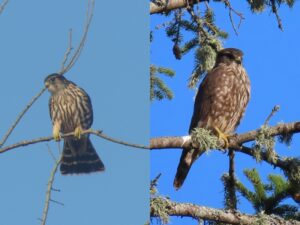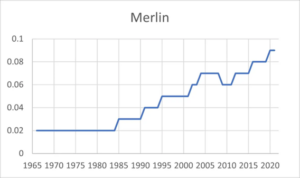(Photos and story by Pam Hunt)

September marks the start of peak raptor migration, and while people particularly like to watch the large kettles of Broad-winged Hawks circling their way south, the antics of southbound Merlins (Falco columbarius) also never fail to entertain. They are fond of dive-bombing the plastic owls stationed at hawk watches (partially for this very purpose – to attract accipiters and falcons) and often seen catching their dragonfly prey and consuming it in mid-air.
These small falcons breed across the northern portions of Eurasia and North America, usually in forest habitats. While long known as migrants through New Hampshire, they were not documented breeding here until 1994 near Lake Umbagog, making this one of relatively few species that have colonized the state from the north. This first nest was part of a wider pattern of southward expansion that began in the 1960s in the Great Plains, finally reaching the northeastern United States in the 1990s. Merlins have now been documented nesting in all corners of the Granite State, and as far south as West Virginia. As they have increased as breeders, Merlins are also becoming more frequent during the winter in parts of southern New Hampshire.

Much of this rapid colonization is the result of Merlins adapting to human dominated landscapes. They typically nest in open areas rather than dense forest, and these conditions are met by city parks, golf courses, and suburban neighborhoods. Like all falcons, Merlins do not build nests of their own and instead lay their eggs in the abandoned nests of crows and hawks. Crows are common in these same areas, and increasing hawk populations may also have helped by providing additional future nest sites.
It has also been proposed that Merlins do well in developed landscapes because of the abundance of prey. In many parts of their wide range, Merlins specialize on locally abundant birds of open areas (e.g., larks and pipits), and non-native species like House Sparrows and European Starlings certainly fit the bill. Prey are almost always caught in flight, often after a long chase. As noted above, large insects such as dragonflies are added to the diet in late summer and fall. Merlins migrating or wintering in coastal areas also take large numbers of small shorebirds.
State of the Birds at a Glance:
- Habitat: Forests and developed areas
- Migration: Variable, some go as far south as Columbia and Venezuela
- Population trend: Strongly increasing
- Threats: Pesticides and other contaminants
- Conservation actions: None identified
More information on “The State of New Hampshire’s Birds” is available here. Full species profiles in the format of “Bird of the Month” are now available here.
